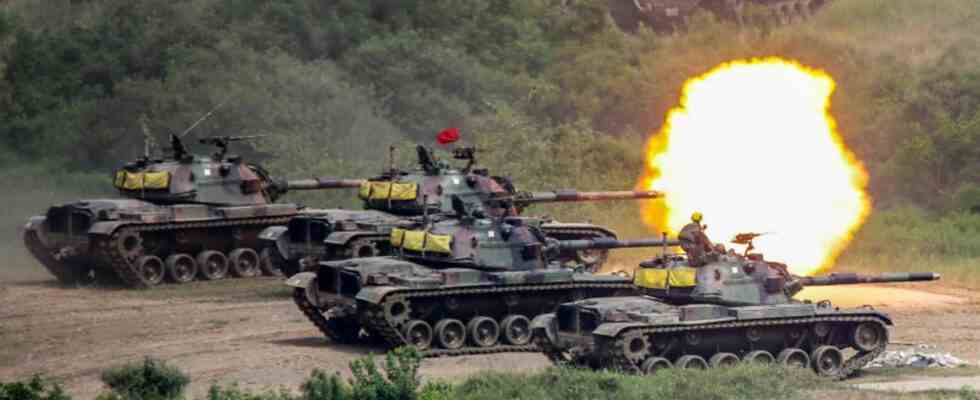According to a simulation, a possible Chinese invasion of Taiwan would fail. The prerequisite would be the support of the USA. And they would have to pay a high price in the event of an attack.
China has been rattling its saber at Taiwan for months. The “Middle Kingdom” sees the democratic island republic as part of its own state. But what would happen if China actually launched an invasion? Authors from the Center for International and Strategic Studies (CSIS) have devoted themselves to precisely this question in a war simulation. They come to the conclusion that if China attacks Taiwan in 2026, an invasion would fail. The island nation would remain a democratic republic provided the US and Japan kept their promise and provided massive military support to Taiwan.
War simulation: China’s invasion of Taiwan would fail – but only under certain circumstances
According to their own statements, the authors of the study constructed a so-called “war game” of a Chinese attack and had it simulated 24 times by computers. Accordingly, the invasion would fail in most cases – at a high cost for all warring parties involved.
The US has repeatedly assured that it will protect Taiwan’s independence against an attack by China. Japan, on the other hand, is neutral in the scenario but supports the US once it enters the war. In addition, the country would allow US forces to use its military bases.
According to the calculations, China would launch a so-called “amphibious” invasion of Taiwan. That means the attack would begin with an opening bombardment by China that would wipe out most of Taiwan’s navy and air force within hours. The Chinese navy would encircle Taiwan and begin bringing a landing force of thousands of soldiers and their equipment across the Formosa Strait – a 180-kilometer-wide strait between China and Taiwan. The most likely scenario would be that Taiwanese troops would try to hold off China’s forces on the coast, according to the report.
The researchers assume that US intervention would come a few days after the first Chinese attack. It would take that long for the General Staff to get an overview of the situation and carry out the mobilization. During this time, the Taiwanese armed forces would have to fight back with all their might and prevent the Chinese troops from setting up bases on the island. Only then would Taiwan have a chance to fend off a Chinese attack.
The US would have to use its army to its full capacity to protect Taiwan
Meanwhile, US submarines, bombers and fighter jets, reinforced by Japanese Self-Defense Forces, would “quickly cripple” the Chinese amphibious fleet, the report said. “China’s attacks on Japanese bases and US surface ships cannot change this result: Taiwan remains autonomous,” the authors say.
The researchers stress, however, that the United States would have to use its full capabilities of the army and bases in Japan to support Taiwan. Otherwise it would not be possible to exploit the clout of their air force in particular. Delays or half-hearted action would significantly increase casualties and make the island’s defense more difficult, the scientists said.
The USA and China would have to be prepared for thousands of deaths – basic services in Taiwan would collapse
According to the authors of the study, even if everything went perfectly from the point of view of Taiwan and the USA, the conflict would be extremely bloody. In the model calculations, they come to the conclusion that the United States and Japan would have to be prepared to accept high losses in order to protect Taiwan. Literally it says: “The United States and Japan are losing dozens of ships, hundreds of aircraft and thousands of soldiers. Such losses would damage the global position of the United States for many years to come.”
In the scenarios played out, China would sink two American aircraft carriers and ten to 20 other warships. 3,200 US soldiers could be killed in just three weeks. According to the simulation, Taiwan’s armed forces would not be completely defeated, but would be severely weakened.
Ukraine war
2022: The year Putin took the aura of greatness from the Russian army
The Chinese army would be hit even harder. Not only would China’s invasion fail in most simulations, but around 10,000 soldiers could also die and tens of thousands more end up as prisoners of war. China would lose 155 aircraft and 138 warships. According to the authors, the Chinese Navy would be “in ruins.”
Simulations reveal many unknown variables
The authors emphasize that the war simulation does not take into account some aspects. Initially, the simulations assumed that Taiwan would not surrender in the event of a Chinese attack. The country must therefore be determined to strike back.
Second, it would be essential that Japan actually authorize American forces to use its military bases. In addition, soft variables such as war morale cannot be predicted. A good example of this is Ukraine’s current readiness to fight against Russia’s attack.
It is also impossible to predict whether the public in the USA and Japan would be willing to accept any losses in order to protect Taiwan. Especially with a view to the fact that this would weaken Washington’s position of power for years to come.
A final unknown variable is whether the US would be willing to attack Chinese territory and risk nuclear war.
But even in the absence of a nuclear standoff, both Taiwan and the US will need to increase their military forces, focusing on the most survivable and effective weapons, to better repel a Chinese invasion, the authors said.
Sources: CSISWith material from DPA

